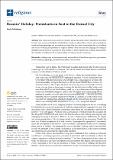Files in this item
Roamin’ holiday : protestants on foot in the Eternal City
Item metadata
| dc.contributor.author | Michelson, Emily D. | |
| dc.date.accessioned | 2023-05-09T08:30:07Z | |
| dc.date.available | 2023-05-09T08:30:07Z | |
| dc.date.issued | 2023-05-06 | |
| dc.identifier | 284057929 | |
| dc.identifier | 77e8858f-85bd-4817-879f-5c4909fb8d38 | |
| dc.identifier | 85160220896 | |
| dc.identifier.citation | Michelson , E D 2023 , ' Roamin’ holiday : protestants on foot in the Eternal City ' , Religions , vol. 14 , no. 5 , 611 . https://doi.org/10.3390/rel14050611 | en |
| dc.identifier.issn | 2077-1444 | |
| dc.identifier.other | ORCID: /0000-0002-7940-9954/work/135018635 | |
| dc.identifier.uri | https://hdl.handle.net/10023/27530 | |
| dc.description.abstract | This article analyses accounts of sixteenth- and seventeenth-century Anglophone travellers to Rome who encountered and described Catholic rituals of walking. These visitors observed Catholic rituals such as pilgrimages and processions so closely that they came to understand the act of walking and ways of walking as expressions of religious identity. They also used the language of walking to interpret such moments of encounter in their narratives. Taken together, this evidence demonstrates the centrality of walking to their understanding of a religiously diverse Europe. | |
| dc.format.extent | 14 | |
| dc.format.extent | 284782 | |
| dc.language.iso | eng | |
| dc.relation.ispartof | Religions | en |
| dc.subject | Walking | en |
| dc.subject | Early modern travel | en |
| dc.subject | Early modern Rome | en |
| dc.subject | Catholicism | en |
| dc.subject | Spectacle | en |
| dc.subject | Processions | en |
| dc.subject | Seven churches | en |
| dc.subject | Pilgrimage | en |
| dc.subject | Reformation | en |
| dc.subject | Judaism | en |
| dc.subject | Protestantism | en |
| dc.subject | BL Religion | en |
| dc.subject | T-NDAS | en |
| dc.subject | MCC | en |
| dc.subject.lcc | BL | en |
| dc.title | Roamin’ holiday : protestants on foot in the Eternal City | en |
| dc.type | Journal article | en |
| dc.contributor.institution | University of St Andrews. St Andrews Institute of Medieval Studies | en |
| dc.contributor.institution | University of St Andrews. School of History | en |
| dc.contributor.institution | University of St Andrews. St Andrews Centre for the Receptions of Antiquity | en |
| dc.identifier.doi | https://doi.org/10.3390/rel14050611 | |
| dc.description.status | Peer reviewed | en |
This item appears in the following Collection(s)
Items in the St Andrews Research Repository are protected by copyright, with all rights reserved, unless otherwise indicated.

